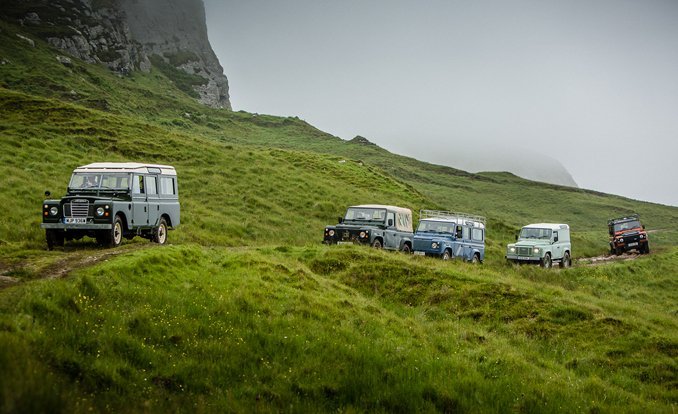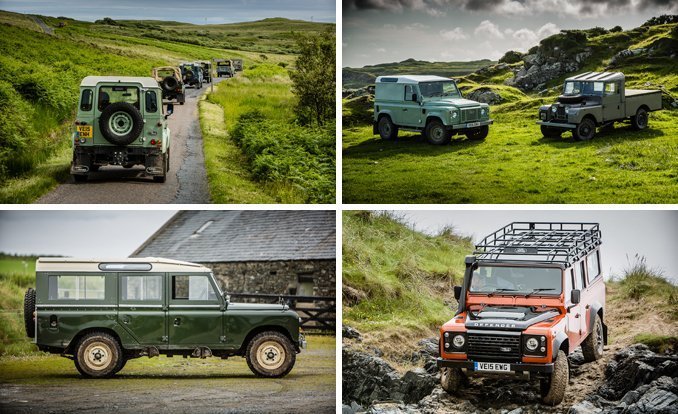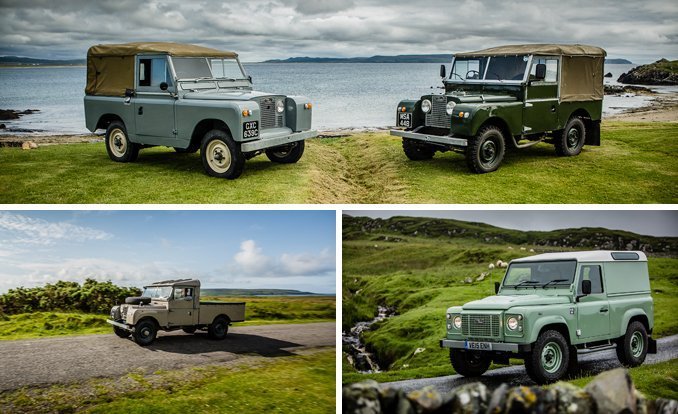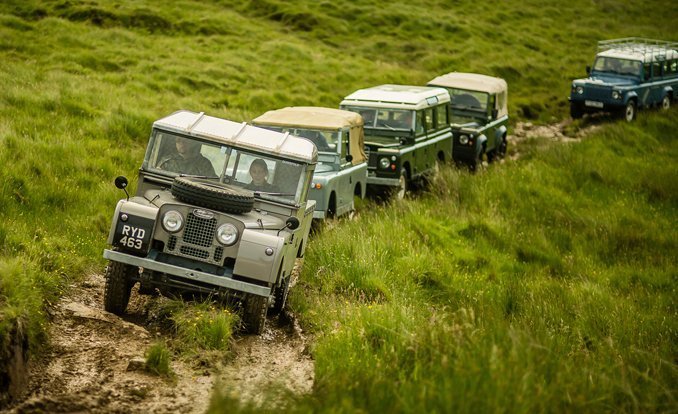
Nothing is more British than the Land Rover Defender. Not the royal family, not warm beer, not even an understanding of cricket’s LBW rule or the baffling urge to have a lovely cup of hot, milky tea when the temperature is nudging 90 degrees Fahrenheit in the shade. Which is why the official retirement of this venerable, but much-loved, automotive fossil has practically triggered a bout of national mourning. So many orders have been placed for the last original Defenders that production, which was to end later this year, has been extended into 2016 to meet demand.
The Defender and some of its precursors were only ever officially sold in the U.S. for relatively short periods, and not since 1997. But the climbing values of good ones in the States—plus the occasional attempts that have been made to cheat the federal import rules by bringing in newer examples—prove the Landie has a strong following here, too. So we were delighted to receive an invitation to travel to Islay, a smallish Scottish island, to drive not only the three limited-edition Defenders that will mark the end of production, but also every one of their forebears back to the original Series I. This is how history should be taught.
The Scottish connection is pleasingly appropriate. Brothers Spencer and Maurice Wilks were the senior Rover executives who originally conceived what became the first Land Rover, at least partly in response to the popularity of World War II–surplus Jeeps in the United Kingdom. According to the corporate legend, the Landie’s boxy shape was first sketched on a beach in northern Wales. But the brothers Wilks, although English, also had a Scottish connection, their family owning an estate on Islay (pronounced “aye-la” by the natives). The new Land Rover supposedly was thought up here over a generous dram of one of the local whiskies, a story we’re sure you’ll agree is too good to be subjected to any excessively diligent research.
We start at the beginning, or close to it. The 107-inch Series I pickup immediately confirms that Land Rover’s evolution was a very gradual one. Parked next to a brand-new Defender, it looks narrow and boxy, but there’s still a very obvious connection despite the six decades that separate the two. The privately owned Series I that Land Rover has brought to the drive event dates from 1954, six years after the start of production. That means it has the later and fractionally more powerful 2.0-liter side-valve four-cylinder engine with 52 horsepower.

Regrettably, the early plans to build the Land Rover with a central driving position—on the basis that most buyers would be farmers switching from tractors—came to naught. But even sitting on the right on a minimally padded seat it’s clear that, compared with most European cars from the 1950s, the Series I has a pretty spacious cabin. A small panel in the middle of the dashboard contains the unlabeled switchgear and the minimal instrumentation: a combined fuel gauge and ammeter on one side and a speedometer that reads to 75 mph on the other. This, we quickly establish, is seriously optimistic.
Islay’s roads are, for the most part, narrow and bumpy, and we’re conscious that we’re driving somebody’s (rare and valuable) pride and joy. This definitely isn’t a performance test, but we soon establish that the Series 1’s comfortable cruising speed is around 45 mph, at which point conversations can still be conducted without quite shouting. The controls have a surprising lightness to them, the whole feels far nimbler than we were expecting, and, beyond some initial slack, the unassisted steering even delivers some nice feedback. But the four-speed manual gearbox lacks synchromesh on first and second, requiring some well-timed double clutching to avoid crunching noises.
Next comes one from 1965, an 88-inch Soft Top (the number refers to the wheelbase). This has the more-powerful, 67-hp 2.25-liter four-cylinder engine that would power Land Rovers for the next two decades, but otherwise it doesn’t feel much different from the S1. Indeed, with shorter gearing, a louder engine, and mushier brakes, there’s little obvious dynamic progress. It does have a direct connection to the island, having originally belonged to Spencer Wilks himself. At least it has a heater.
The Series III delivers the first discernible evolution. The 1980 109-inch station wagon that Land Rover has provided has some nonmetal interior surfaces and radical innovations such as column-mounted wiper and turn-signal stalks, plus a fully synchromesh four-speed manual transmission. The quality of the cabin plastics are as low as you would expect from a vehicle manufactured during the dark days of British Leyland, but despite being powered by the same 2.25-liter engine (now with 77 horsepower!) it feels considerably more modern to drive on-road. We get to take this one off pavement as well, engaging four-wheel drive and low range to tackle a muddy two-track and then a rock-strewn descent onto a beach, all accomplished without any drama. More important, the Series III also was the first Land Rover to get bug screens for the pop-open air vents beneath the windshield, likely prompting some of the brand’s early aficionados to accuse it of becoming a bit soft.
A Series IV should turn up next, but Land Rover switched to a new, non-Series-based naming strategy in 1983 to mark the radical shift to an entirely new chassis with coil-sprung suspension components at each corner. Yes, the Series III successor is a Defender, but that designation came later, in 1990, not long before Land Rover tried another of its periodic relaunches in the States and the marketing department ordered names instead of numbers. Before then, the pre-Defender was just known by its wheelbases: 90, 110, and 130.

There are two from this era to drive, both 1988 models. A 90 Soft Top has a 2.5-liter turbo-diesel engine while a 110 Station Wagon has the rare (but desirable) option of the long-serving 3.5-liter Rover V-8, here in ultra-laid-back 134-hp tune. From the outside, both look almost identical to the modern Defender. But inside, the low-grade interior trim and widely scattered switchgear feel closer to the Series III. The 90 is a disappointment, all diesel and no turbo—it’s loud, laggy, and gutless. By contrast, the V-8 is lovely, with a wuffling soundtrack and enthusiastic responses that almost disguise the fact that it’s actually not much quicker. It’s definitely the most C/D choice here, especially with the reasonably precise manual gearbox. The roughly 12-mpg thirst is more of a problem, though, especially with a liter of gas on Islay costing around £1.30; that’s more than $7.50 per gallon.
Which brings us to a lesson in relativism. We’re fairly confident the three modern Defender Special Editions felt so fast and agile because we’d just spent hours in their predecessors. Indeed, they all felt like sports cars. The steering is far tighter than in even the early Defenders, and the gruff-sounding Ford-sourced 2.2-liter turbo-diesel provides vastly more urge than even the V-8.
It’s the same story in the cabin; it’s vastly better, but only for as long as you are comparing it to earlier Land Rover products. There’s a tachometer on the dashboard, not a luxury seen in any of the earlier versions. The Defender gained rotary heater controls for the last few years of its life; there’s even air conditioning. As a bonus, nostalgic Brits can spend hours arguing about which long-dead Rover products various bits of switchgear have come from. (For the record, we think the turn-signal stalk and headlight switch are from a 1981 Austin Mini-Metro.)

Three run-out models are being offered. The Heritage Edition plays most directly on the Land Rover’s long history, with a retro green-and-white paint scheme and Series-style front grille. The Autobiography gets two-tone paintwork, stitched-leather panels inside, and a modest power increase (from 120 horsepower to 148; zero to 60 mph is claimed to take “just” 12.7 seconds). It also has a fairly ridiculous price tag, clearly aimed at the deeply pocketed reminiscent: £61,845 is $96,500 at current exchange rates, more than double the price being asked for the Heritage Edition. Finally, there’s the Adventure Edition, with the radioactive orange of the car we drove channeling the spirit of the former Land Rover G4 endurance challenge. It’s the toughest looking, replete with a full off-road kit including sill guards and with an expedition-spec roof rack. It’s the one that we would have opted to drive home had we been given the choice. Sadly, we weren’t.
The basic Land Rover has long been one of the automotive cults the British seem particularly susceptible to falling under the influence of; each one is as proudly eccentric as any Caterham, Morgan, or TVR. If this Land Rover had evolved at anything beyond the very gradual rate it did then much of its charm likely would have been lost, an issue its lifestyle-focused successor will have to face head-on.
There’s a final twist to the tale. Although there’s no official confirmation, Land Rover is said to be considering moving production of the classic Defender to an overseas plant, most likely in India, so it can carry on in the parts of the world that are less fastidious about things such as airbags and stability control. So this might not be the last time we get to say goodbye to this particular icon.